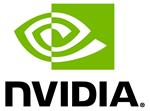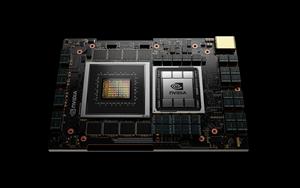- ‘Grace’ CPU delivers 10x performance leap for systems training giant AI models, using energy-efficient Arm cores
- Swiss Supercomputing Center and US Department of Energy’s Los Alamos National Laboratory First to Build NVIDIA CPU-Powered Supercomputers
SANTA CLARA, Calif., April 12, 2021 (GLOBE NEWSWIRE) -- GTC -- NVIDIA today announced its first data center CPU, an Arm-based processor that will deliver 10x the performance of today’s fastest servers on the most complex AI and high performance computing workloads.
The result of more than 10,000 engineering years of work, the NVIDIA Grace™ CPU is designed to address the computing requirements for the world’s most advanced applications — including natural language processing, recommender systems and AI supercomputing — that analyze enormous datasets requiring both ultra-fast compute performance and massive memory. It combines energy-efficient Arm CPU cores with an innovative low-power memory subsystem to deliver high performance with great efficiency.
“Leading-edge AI and data science are pushing today’s computer architecture beyond its limits – processing unthinkable amounts of data,” said Jensen Huang, founder and CEO of NVIDIA. “Using licensed Arm IP, NVIDIA has designed Grace as a CPU specifically for giant-scale AI and HPC. Coupled with the GPU and DPU, Grace gives us the third foundational technology for computing, and the ability to re-architect the data center to advance AI. NVIDIA is now a three-chip company.”
Grace is a highly specialized processor targeting workloads such as training next-generation NLP models that have more than 1 trillion parameters. When tightly coupled with NVIDIA GPUs, a Grace CPU-based system will deliver 10x faster performance than today’s state-of-the-art NVIDIA DGX™-based systems, which run on x86 CPUs.
While the vast majority of data centers are expected to be served by existing CPUs, Grace — named for Grace Hopper, the U.S. computer-programming pioneer — will serve a niche segment of computing.
The Swiss National Supercomputing Centre (CSCS) and the U.S. Department of Energy’s Los Alamos National Laboratory are the first to announce plans to build Grace-powered supercomputers in support of national scientific research efforts.
NVIDIA is introducing Grace as the volume of data and size of AI models are growing exponentially. Today’s largest AI models include billions of parameters and are doubling every two-and-a-half months. Training them requires a new CPU that can be tightly coupled with a GPU to eliminate system bottlenecks.
NVIDIA built Grace by leveraging the incredible flexibility of Arm’s data center architecture. By introducing a new server-class CPU, NVIDIA is advancing the goal of technology diversity in AI and HPC communities, where choice is key to delivering the innovation needed to solve the world’s most pressing problems.
“As the world’s most widely licensed processor architecture, Arm drives innovation in incredible new ways every day,” said Arm CEO Simon Segars. “NVIDIA’s introduction of the Grace data center CPU illustrates clearly how Arm’s licensing model enables an important invention, one that will further support the incredible work of AI researchers and scientists everywhere.”
Grace’s First Adopters Push Limits of Science and AI
CSCS and Los Alamos National Laboratory both plan to bring Grace-powered supercomputers, built by Hewlett Packard Enterprise, online in 2023.
”NVIDIA’s novel Grace CPU allows us to converge AI technologies and classic supercomputing for solving some of the hardest problems in computational science,” said CSCS Director Prof. Thomas Schulthess. “We are excited to make the new NVIDIA CPU available for our users in Switzerland and globally for processing and analyzing massive and complex scientific datasets.”
“With an innovative balance of memory bandwidth and capacity, this next-generation system will shape our institution’s computing strategy,” said Thom Mason, director of the Los Alamos National Laboratory. “Thanks to NVIDIA’s new Grace CPU, we’ll be able to deliver advanced scientific research using high-fidelity 3D simulations and analytics with datasets that are larger than previously possible.”
Delivering Breakthrough Performance
Underlying Grace’s performance is fourth-generation NVIDIA NVLink® interconnect technology, which provides a record 900 GB/s connection between Grace and NVIDIA GPUs to enable 30x higher aggregate bandwidth compared to today’s leading servers.
Grace will also utilize an innovative LPDDR5x memory subsystem that will deliver twice the bandwidth and 10x better energy efficiency compared with DDR4 memory. In addition, the new architecture provides unified cache coherence with a single memory address space, combining system and HBM GPU memory to simplify programmability.
Grace will be supported by the NVIDIA HPC software development kit and the full suite of CUDA® and CUDA-X™ libraries, which accelerate more than 2,000 GPU applications, speeding discoveries for scientists and researchers working on the world’s most important challenges.
Availability is expected in the beginning of 2023.
Learn more at GTC21, taking place online April 12-16 — registration is free.
About NVIDIA
NVIDIA’s (NASDAQ: NVDA) invention of the GPU in 1999 sparked the growth of the PC gaming market and has redefined modern computer graphics, high performance computing and artificial intelligence. The company’s pioneering work in accelerated computing and AI is reshaping trillion-dollar industries, such as transportation, healthcare and manufacturing, and fueling the growth of many others. More information at
https://nvidianews.nvidia.com/.
For further information, contact:
Kristin Bryson
Senior Director, Enterprise Communications
NVIDIA Corporation
+1-203-241-9190
Email Contact
Certain statements in this press release including, but not limited to, statements as to: the features, performance, benefits, impact and availability of the Grace CPU; CSCS’s and Los Alamos National Laboratory’s plans to build Grace-powered supercomputers and bring them online by 2023; the growth of AI models; data centers being served by CPUs; Grace serving a niche segment of computing; leading-edge AI and data science pushing today’s computer architecture beyond its limits — processing unthinkable amounts of data; the training of AI models requiring a new CPU; NVIDIA advancing the goal of technology diversity in AI and HPC communities; the flexibility of Arm’s open architecture driving innovation; and Arm enabling invention and supporting the work of AI researchers and scientists are forward-looking statements that are subject to risks and uncertainties that could cause results to be materially different than expectations. Important factors that could cause actual results to differ materially include: global economic conditions; our reliance on third parties to manufacture, assemble, package and test our products; the impact of technological development and competition; development of new products and technologies or enhancements to our existing product and technologies; market acceptance of our products or our partners' products; design, manufacturing or software defects; changes in consumer preferences or demands; changes in industry standards and interfaces; unexpected loss of performance of our products or technologies when integrated into systems; as well as other factors detailed from time to time in the most recent reports NVIDIA files with the Securities and Exchange Commission, or SEC, including, but not limited to, its annual report on Form 10-K and quarterly reports on Form 10-Q. Copies of reports filed with the SEC are posted on the company's website and are available from NVIDIA without charge. These forward-looking statements are not guarantees of future performance and speak only as of the date hereof, and, except as required by law, NVIDIA disclaims any obligation to update these forward-looking statements to reflect future events or circumstances.
© 2021 NVIDIA Corporation. All rights reserved. NVIDIA, the NVIDIA logo, CUDA, CUDA-X AI, DGX, NVIDIA Grace, and NVLink are trademarks and/or registered trademarks of NVIDIA Corporation in the U.S. and other countries. Other company and product names may be trademarks of the respective companies with which they are associated. Features, pricing, availability and specifications are subject to change without notice.
A photo accompanying this announcement is available at https://www.globenewswire.com/NewsRoom/AttachmentNg/b3cfff26-6195-4f21-a7cc-55f7f16af7a6

